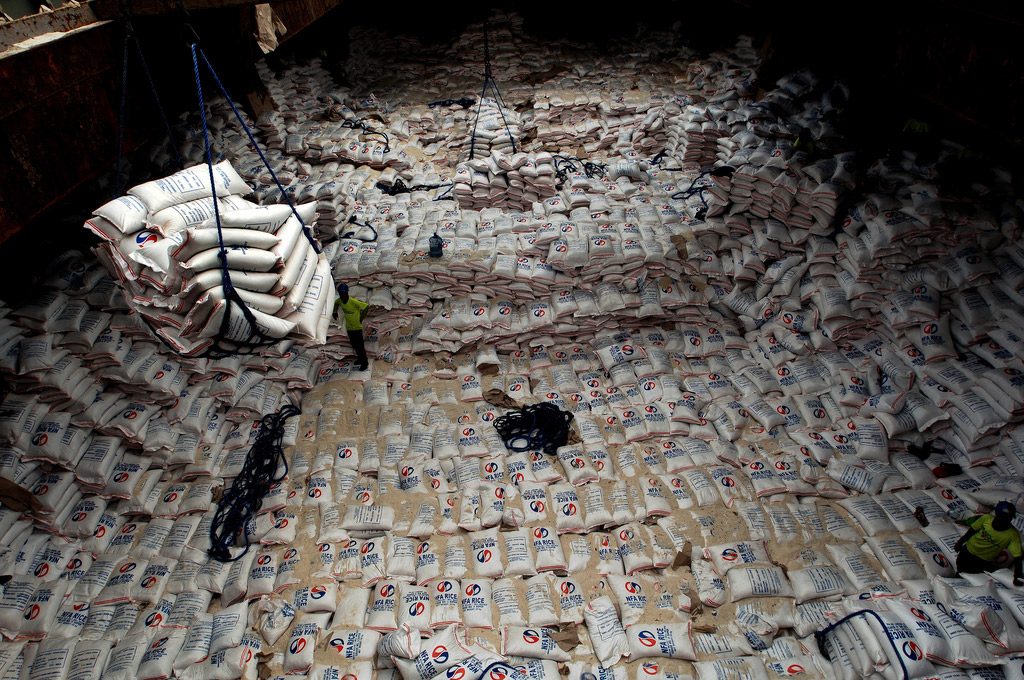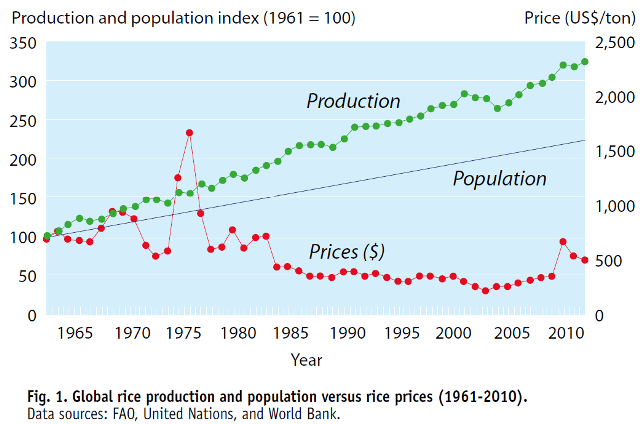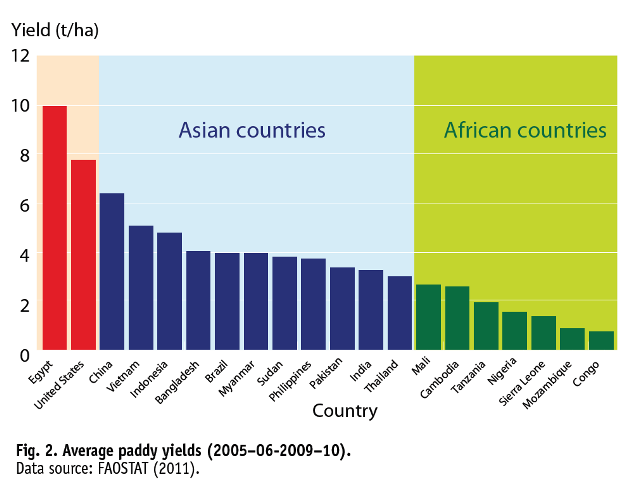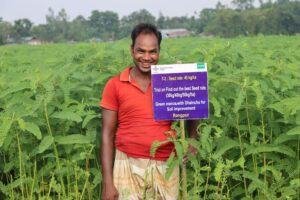
World population is projected to reach 7 billion by the end of this month (October 2011). Unfortunately, this historic moment arrives when the world has serious concern about future global food security. In the past 4 years, the world witnessed two food price spikes with greater price volatility that has affected millions of poor people. The factors underlying rising food prices are decelerating productivity growth coupled with greater occurrence of extreme weather, and the effects have been magnified by inward-looking domestic and trade policies of the major rice-growing countries. In addition, rice prices have been highly volatile in recent years, moving up and down by US$50 to $100 per ton in a matter of weeks in response to various fundamental and speculative factors. In the past few months alone, rice prices increased by more than $100 per ton primarily in anticipation of a possible reintroduction of the rice mortgage program in Thailand.
Rising food security concerns
Many Asian countries faced acute food shortages and struggled to feed their rapidly expanding population because of frequent famine and drought before the beginning of the Green Revolution in the late 1960s. Africa’s health and nutrition status then was even slightly better than that of Asia. The life expectancy of most people in Asian countries was less than 50 years and infant mortality was unbelievably high, at 125–150 deaths per 1,000 births, compared with 100–300 deaths per 1,000 births in Africa.
The Green Revolution’s first product—high-yielding semi-dwarf rice variety IR8—and the release of more than 1,000 additional modern varieties in the next half century changed the landscape of the entire Asian continent. During this period, global paddy rice production more than doubled from 312 million tons in 1970-71 to 677 million tons in 2010-11. Rice production growth has been so strong that it exceeded population growth during the entire Green Revolution era, which caused rice prices to decline by more than 70% (Fig. 1). Now, the health and nutrition status of the Asian population is much better than what it was before the Green Revolution.
Beyond the agricultural sector, lower rice prices during the Green Revolution era kept the wage rate low, contributing to faster overall growth of the Asian economy. The transformation of Asian countries from food deficit to self-sufficiency enabled them to use foreign exchange for infrastructure and other development activities rather than using it for food imports. Overall, the Green Revolution was a resounding success in expanding food production and improving the lives of hundreds of millions of poor people despite many criticisms on environmental and land degradation caused by the excessive use of fertilizers, pesticides, and irrigation water; groundwater pollution; and erosion of genetic diversity.
However, the annual yield growth rate of rice in the last decade has dropped to less than 1% compared with 2–3% during the Green Revolution period of 1967-90. With effects of the Green Revolution fading, the debate on rising hunger, malnutrition, and food insecurity is taking center stage once again. Two food price spikes in the past 4 years have shaken the foundation of global food security and concern has been raised as to whether the global food system can feed the world population, which is estimated to reach 9 billion in 2050.
Talks on food security now find their way onto the agenda of many global and regional forums such as G8, G20, the Asia Pacific Economic Conference (APEC), the Association of Southeast Asian Nations (ASEAN), and the South Asian Association of Regional Cooperation (SAARC).
Food security experts, policymakers, and other stakeholders call for another Green Revolution. However, everyone realizes that the approach adopted that led to the success of the first Green Revolution may not be applicable now. This time around, we need to think about 7 billion hungry mouths—twice the population the world had in the late 1960s that marked the beginning of the Green Revolution. During the first Green Revolution, many Asian countries aimed at achieving rice self-sufficiency by encouraging farmers to expand production through subsidized inputs and assured markets for their products. Farmers responded by adopting input-responsive high-yielding modern varieties and bringing additional land into crop production.
In the past 5 decades, nearly 25% of the production growth has come from area expansion, whereas 75% has come from yield growth. Area expansion, which includes both physical area and greater cropping intensity on the same piece of land, was made possible because of better infrastructure and the development of short-duration varieties.
To continue this trend is not a viable option for most Asian rice-growing countries, where additional land is no longer available and pressure on the existing rice land from urbanization and other nonagricultural uses is growing rapidly. This is particularly true for China, India, Indonesia, Thailand, the Philippines, and Bangladesh, which account for nearly 70% of global rice production and consumption. For example, China’s rice area has declined by more than 5 million hectares (15%) in the past 3 decades and the downtrend may continue in the future. Although a similar downtrend has not been evident in other rice-growing countries in the region because of government interventions, it is hard to foresee how governments can continue with such interventions in the face of rising costs, water shortages, and growing pressure from competing sectors.
The few exceptions could be countries such as Cambodia and Myanmar, which were left out of the Green Revolution for varying reasons but they could be stimulated to expand rice production by developing infrastructure and providing better market linkages.
Toward a stable future
The future of global rice food security depends on the strategies of the major rice-growing countries in Asia. If these rice-growing countries decide to pursue self-sufficiency, opportunity will be less for any structural transformation of the global rice market, keeping it volatile with frequent price spikes in years of tight supply. However, if these countries send a clear signal to the world of their long-term food security strategy and their intention to depend on the global rice market for a certain percentage of their domestic consumption, a massive change in the global rice industry could be on the horizon. Their intention should be reflected in the form of fewer trade restrictions such as an export ban, and minimum export or import prices, and allowing private traders to take charge of exports and imports rather than state trading agencies. This will allow investment to flow into countries endowed with land and water to take advantage of the growing rice market.
The change in the global soybean market 3 decades ago may provide a clue as to what could happen in the rice market. In the soybean market, the United States used to be a big guy on the block. The country represented around 80% of world production and 95% of total exports during the 1960s and 1970s. The ban on soybean exports imposed by the U.S. in the early 1970s altered the entire landscape of soybean production and trade when other countries started looking for alternative suppliers.
China, Japan, and the European Union invested heavily in developing infrastructure in South America. And, in 2 decades, two South American neighbors, Argentina and Brazil, emerged as formidable competitors to the U.S. in the world soybean market. Now, these countries account for around half of the global soybean trade. The emergence of many dependable suppliers also convinced many countries, including China, Japan, the European Union countries, Taiwan, South Korea, and others, to liberalize their oilseed sector. For example, China has imported 52 million tons in 2010-11. This is 79% of the total domestic consumption, which is in stark contrast to its negligible imports until 1990.
Similar to the soybean transformation, potential exists for expansion of rice production in sub- Saharan Africa (SSA) and Latin America. Many SSA countries have land and water but they could not realize their full potential because of political instability, poor infrastructure, and inefficient supply chains. These constraints have kept paddy yields in many SSA countries much lower than in their Asian counterparts (Fig. 2). At the same time, many Latin American countries such as Brazil, Argentina, Uruguay, and Paraguay can expand rice production as long as a market is available for their rice and it is more profitable than competing crops such as soybean, cotton, and wheat.











